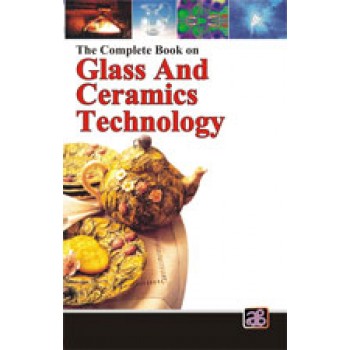The Complete Book on Glass and Ceramics Technology
| Price: | Rs.1,275.00 |
Detail Of The Complete Book on Glass and Ceramics Technology
| ISBN | 8178330334 |
| Pages | 624 |
| Language: | English |
| Product Code: | 1 |
| Size(in cm): | 21*13.5 cm |
| Weight(in grams): | 500(approx) |
Description:
The technology of glass ceramics are now a day wide field involving a great variety of raw materials, manufacturing processes, as well as products, and of considerable diversity in theoretical background. The manufacture of traditional glasses and ceramics is based on the utilization of the most widely occurring natural raw materials. Glass is an inorganic product that is typically produced by melting a mixture of silica, soda and calcium compound with the desired metallic oxides that serve as colouring agents. The glass industry covers products such as silicate glasses, phosphate glasses, germanate glasses, halide glasses, nitrate glasses etc. Glass products are used widely in households, construction, laboratories and consumer items such as bangles, beads, pearls, etc. A ceramic is an inorganic, nonmetallic solid prepared by the action of heat and subsequent cooling. Ceramic materials may have a crystalline or partly crystalline structure, or may be amorphous (e.g., a glass). Because most common ceramics are crystalline, the definition of ceramic is often restricted to inorganic crystalline materials, as opposed to the noncrystalline glasses. Commercial application of glass ceramics are dinnerware, fine mesh screens, cookware, burner covers, semiconductor doping sources etc. The domestic glass industry is facing increasing competition in the global, as well as domestic markets. State of the art technology in manufacturing is becoming increasingly important in the industry. Modern technology and operations are replacing traditional methodologies in fibre glass composites. The demand for ceramic and glass products is growing globally with over 90 percent of the total demand for advanced ceramic materials coming from electronic goods and allied industries, thanks to the product ability to withstand extreme environmental conditions.
This book majorly deals with types of glasses, silicate glasses, boric oxide and borate glasses, phosphorus pentoxide and phosphate glasses, germanium dioxide and germanate glasses, titanate glasses, nitrate glasses, glasses based on water, halide glasses, modern glass working, monax and pyrex glass, electric welding, photo electric cells, glassy metals, analysis of glass, glass ceramics, ceramics as electrical materials, analysis of ceramics etc.
The technology of glass ceramics are now a day wide field involving a great variety of raw materials, manufacturing processes, as well as products, and of considerable diversity in theoretical background. The manufacture of traditional glasses and ceramics is based on the utilization of the most widely occurring natural raw materials. The efforts have been made to provide maximum and latest information about processing of glass and ceramics and their products in this book. This book is an invaluable resource for entrepreneurs, technocrats, manufacturers of glass and ceramic products, research scholars, technical institutions etc.
Reviews (0)
Write a review
Your Name:Your Review:
Note: HTML is not translated!
Rating: Bad Good
Enter the code in the box below:



 |
| 